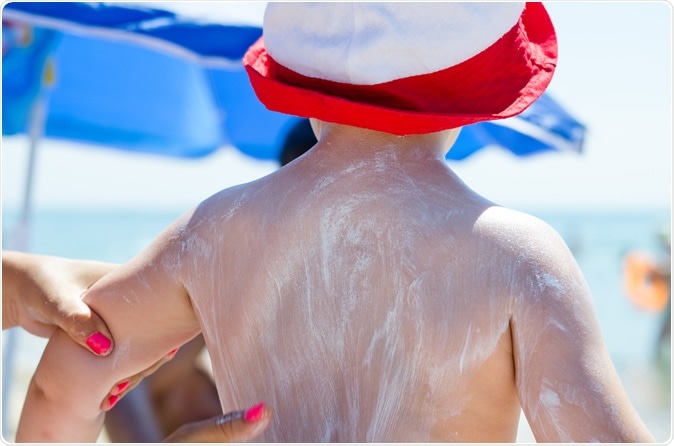A new study has analyzed the amount of sunscreen ingredients that get absorbed into the blood stream via the skin. The study titled, “Effect of Sunscreen Application on Plasma Concentration of Sunscreen Active Ingredients A Randomized Clinical Trial,” was published in the latest issue of the journal JAMA.

Image Credit: Oleg Mikhaylov / Shutterstock
This study does not advocate the general population from not using sunscreens while stepping out into the sun say the experts on the team. They write that sunscreens are the best protection from getting skin cancers due to exposure to the harmful ultraviolet rays of the sun.
This was a randomized clinical trial that included 48 healthy adult volunteers. David G. Strauss, M.D., Ph.D., U.S. Food and Drug Administration, Silver Spring, Maryland and other researchers from the US FDA conducted this study where they looked at the absorption levels of sunscreen ingredients including “avobenzone, oxybenzone, octocrylene, homosalate, octisalate and octinoxate.” These six ingredients were assessed in four sunscreen products available as lotions, aerosols, sprays or pumps.
The team wrote that there has been a 2019 study from the FDA published in the same journal that looked at these six ingredients present in the four sunscreen products. These six chemicals were found to have been absorbed into the blood streams of the persons applying them over their skin. The levels of these chemicals found in the blood, in the last FDA study were also much above the recommended safe levels by the FDA, wrote the researchers. They wrote that the recommended safe blood levels are 0.5 ng/ml of these chemicals. This had prompted the researchers to look at the safety of these chemicals once they were in the blood stream at such high levels.
For this study the team conducted a clinical trial at the Clinical Pharmacology unit (West Bend, Wisconsin) including 48 healthy adults. The persons were recruited for the study between January and February 2019. The study was funded and conducted by the US FDA. The participants were of an average age of around 39 years. There were equal number of men and women among the volunteers. Of the participants there were 23 whites, 23 of African American descent and 1 each was of Asian descent and 1 was on unknown race or ethnicity. The trial was completed by 44 individuals.
Each of the participants were randomly allocated to be part of one of the four study groups. Each of the groups were asked to use one of the four tested sunscreen products. The products were a lotion (this group had 12 participants), aerosol spray formulation (12 participants), non-aerosol spray (12 participants) and pump spray formulation (12 participants). The amount of sunscreen to be applied was ear marked at 2 mg/cm2 over 75 percent of the body surface area. The amount was to be applied at the start of the assessment at 0 hours on day 1. The application was to be repeated on day 2 when the sunscreens were applied four times a day. It was applied regularly till day 4 when it was applied every 2 hourly. Over 21 days of the study, the participants were asked to provide 34 blood samples.
Results revealed that between days 1 and 21 the highest amount of chemical in the sunscreen found in the participants’ blood samples was avobenzone. Maximum amounts of other chemicals oxybenzone, octocrylene, homosalate, octisalate, and octinoxate were also noted over 21 days of the study from the study participants. Each of the ingredients were found to be over 0.5 ng/mL. This is the recommended threshold by the FDA. The blood level of each of the chemical ingredient surpassed this level on day 1 of application of the sunscreen. The amount of avobenzone in blood was “7.1 ng/mL (73.9%) for lotion, 3.5 ng/mL (70.9%) for aerosol spray, 3.5 ng/mL (73.0%) for nonaerosol spray, and 3.3 ng/mL (47.8%) for pump spray” on the first day of application, wrote the researchers. The amount in blood rose with rising frequency of application on day 4 the team explained. The researchers also reported that the commonest side effect of the sunscreen noted was skin rash and it was seen in 14 participants.
The researchers wrote in conclusion, “all 6 of the tested active ingredients administered in 4 different sunscreen formulations were systemically absorbed and had plasma concentrations that surpassed the FDA threshold for potentially waiving some of the additional safety studies for sunscreens. These findings do not indicate that individuals should refrain from the use of sunscreen.”
Journal reference:
Matta MK, Florian J, Zusterzeel R, et al. Effect of Sunscreen Application on Plasma Concentration of Sunscreen Active Ingredients: A Randomized Clinical Trial. JAMA. 2020;323(3):256–267. doi:10.1001/jama.2019.20747